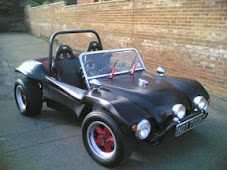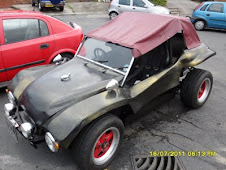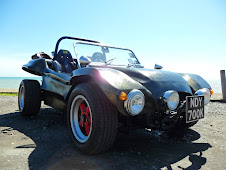
I had been having difficulty keeping the car battery charged on the buggy. Initially I thought this was because the engine was never run properly as it was garaged. I bought a further battery and charged them in rotation. I was not sure that a good run would not dry out the alternator and allow the battery to charge , however I had not been able to give the car a run. A short run when the sunshine eventually came out proved that the charging system was not functional and that either the wiring was faulty or the Alternator had died.
There are only three wires connected to an alternator in this case my original unit was a Motorola. One wire feed the charge to the battery, one wire was an earth and the third wire was a positive supply through the ignition light that feed the primary coils. A few checks with my multimeter proved that the wiring was intact and the alternator was at fault.
I removed the Alternator that afternoon the progress of this was very slow as its a fairly large procedure to remove the item. The problem being that the fan housing needs to be removed and this of course means that many ancillary items have to come off to to get it loose. Primarily the one carb and linkage kit and the fan thermostat and associated tinware. The idea is to undo the bolts holding the alternator to the fan housing and undo the bolts on the alternator pedestal and the alternator strap which hold the alternator onto the pedestal. To get to any of this my fan cover had to be removed first.
Once I had the Alternator removed I decided to strip it down and see if there was a fault with the brushes or bearings. The Alternator was not very old and had seen not much where so I was not surprised to see the bearings solid. Additionally the brushes where accessible by removing a plate from the top of the Alternator. This whole section comes out and clearly the brushes where in very good hart to. I could see that the coils were not black and could only presume that the fault was with the regulator circuitry.
I contacted several companies for a replacement and found that the best price I could get for a replacement swap out would be £91.00 and this was from a friends company. I put my Alternator back together and took it over to him to as this was an exchange unit price.
Several days later Rob called and said the Alternator was in. I drove over an picked it up and was surprised that it seemed a little smaller.
The installation of the Alternator is the reverse of the removal process. The Fan housing needs to be propped up a little by would so that it creates enough room to get the Alternator and stand in place. Usually 1 1/2 inches is OK and the Alternator and stand can be placed in situe.
Once the Alternator an stand are in place they stand can be bolted down and the fan housing can be lowered back in place. This can take a little jiggle as the fan housing is a tight fit between the cylinder shrouds a screw driver is useful to pry them apart whilst the fan finds its seating. Ensure you have not trapped the thermostat flap control rod as this needs to pass through cylinder #1 and #2 down to the thermostat. The thermostat screws onto this rod and then bolts into a frame which is secured to the engine block.
 Once in the Bosch Alternator was a much nicer unit. When I had manufactured my fan housing I had had real problem securing it as it vibrated on the Alternator . The Bosch unit had a ring around the edge of the unit that my fan housing fitted into beautifully.
Once in the Bosch Alternator was a much nicer unit. When I had manufactured my fan housing I had had real problem securing it as it vibrated on the Alternator . The Bosch unit had a ring around the edge of the unit that my fan housing fitted into beautifully.Once the unit is in I turned the engine over by hand to ensure that nothing was grating or grinding. Once this was OK I turned the engine over and the engine fired into life. The initial voltage through to the battery was 12v and I wondered why the battery was not showing 14v . I flicked the throttle and the voltage increased 14.5v the battery was charging and my problem was solved.






















No comments:
Post a Comment